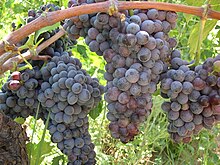Cirò (wine)
Under the name of Ciro DOC are white , rosé and red wines from the southern Italian province of Calabria called, where the latter is the most common representatives of the wine. The wines have had a "controlled designation of origin " ( Denominazione di origine controllata - DOC) since 1969 , which was last updated on March 7, 2014.
origin
It is believed that viticulture was introduced to the Magna Graecia by the Greeks in the 8th century BC. Introduced. The wine was almost exclusively of regional importance. It was not until the 1980s that individual producers in the wine-growing region began to focus on quality and make the Cirò known nationwide.
Cultivation
The cultivation and vinification of the wines are permitted in the municipalities of Cirò and Cirò Marina and partly in the municipalities of Melissa and Crucoli in the Italian province of Crotone in the Calabria region . Cirò DOC is the largest wine-growing region in Calabria. In 2017, 36,959 hectoliters of DOC wine were produced.
Manufacturing
- The Ciro Rosso consists of at least 80% Gaglioppo . A maximum of 20% red grape varieties approved for cultivation in the Calabria region may be added. The grape varieties Barbera , Cabernet Franc , Cabernet Sauvignon , Sangiovese or Merlot may, however, contain a maximum of 10%.
- The Cirò Bianco consists of at least 80% Greco Bianco . A maximum of 20% of other white grape varieties approved for cultivation in the Calabria region may be added.
- Special predicates
- "Classico" describes wines from the immediate areas around the communities of Cirò (Calabria) and Cirò Marina, which are considered to be the most traditional wine-growing areas.
- "Riserva" refers to red wines that have been stored at the producer for at least two years.
description
According to the denomination:
Cirò Rosso
- Color: more or less intense ruby red, with violet reflections - tends to garnet red with increasing maturity
- Smell: pleasant, delicate, intensely vinous
- Taste: dry, full-bodied, warm, harmonious, velvety with increasing maturity
- Alcohol content: at least 12.5 % by volume
- Acidity : at least 4.5 g / l
- Dry extract: at least 20.0 g / l
Cirò Rosato
- Color: more or less intense pink
- Smell: delicate, vinous
- Taste: from dry to semi-dry, fresh, harmonious and pleasant
- Alcohol content: at least 12.5 % by volume
- Acidity : at least 4.5 g / l
- Dry extract: at least 17.0 g / l
Cirò Bianco
- Color: more or less intense straw yellow, sometimes with greenish reflections
- Smell: harmonious, pleasant
- Taste: from dry to semi-dry, fresh, harmonious, delicate, characteristic
- Alcohol content: at least 11.0 % by volume
- Acidity : at least 4.5 g / l
- Dry extract: at least 16.0 g / l
literature
- Nino Aiello et al. a .: Vini d'Italia 2008. Hallwag, Rome 2007, ISBN 978-3-8338-1097-8 .
- Eva Gründel, Heinz Tomek: Southern Italy. DuMont, Cologne 1998, ISBN 3-7701-4351-5 .
- Steffen Maus: Italy's wine worlds - wine, vino, wine . Gebrüder Kornmayer, 2013, ISBN 978-3-942051-18-7 .
- Valeria Camaschella (Ed.): Lexicon of Italian Wines - All DOCG & DOC wines . Hallwag, Gräfe and Unzer, Munich 2002, ISBN 3-7742-0756-9 , p. 254 .
Web links
- Map and list of growing areas in Calabria on federdoc.com; accessed on January 16, 2017
- (The only notable Calabrian winery) librandi.it
Individual evidence
- ↑ a b c d Disciplinare di Produzione della Denominazione di Origine Controllata (production regulations and description). (PDF) In: ismeamercati.it. November 27, 2017, accessed August 4, 2018 (Italian).
- ↑ Viticulture in figures 2018. (PDF) In: VQPRD d'Italia 2018. federdoc.com, accessed on June 4, 2019 (Italian).



